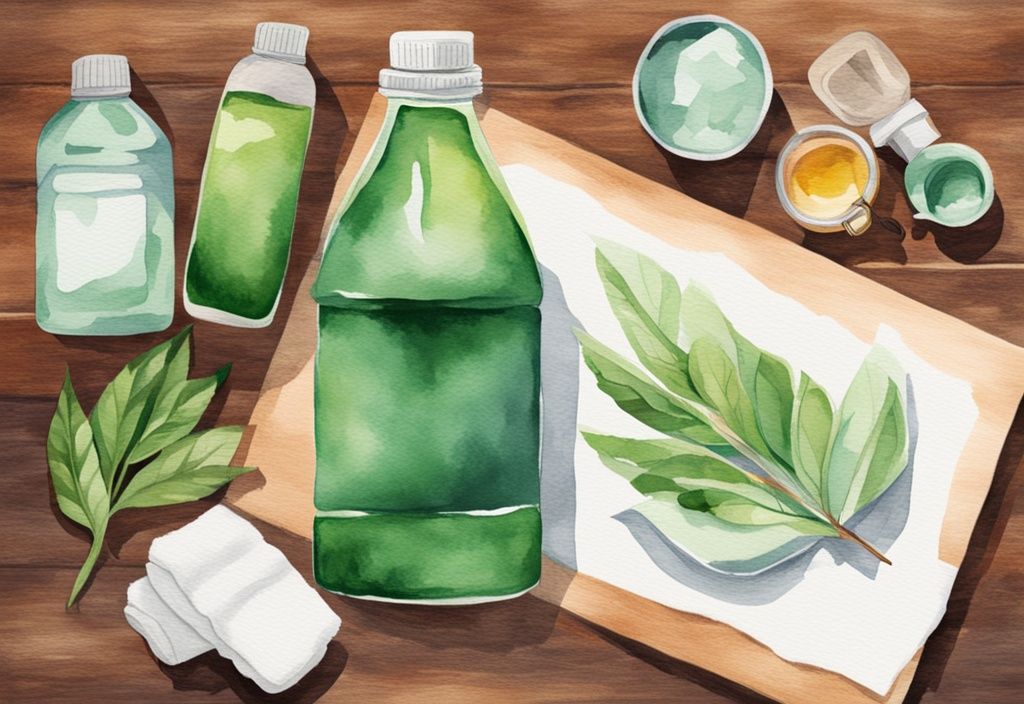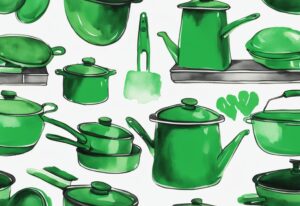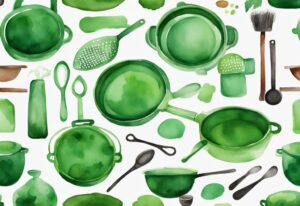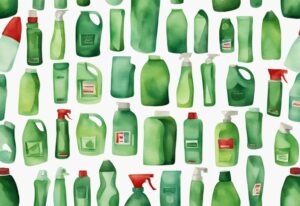Easy Guide: How to Make Non Toxic Laundry Detergent at Home
Ever paused mid-loading your washing machine, wondering what kind of chemicals are in your detergent? Hi, I’m Olivia Green and like yourself, I pondered this question often. The result? I decided to ditch those store-bought detergents and kick-started my journey towards making my own non-toxic laundry detergent.
In this detailed guide, you will discover how to swap harmful substances for all-natural ingredients in your laundry routine. If you prefer either powdered or liquid detergent, don’t worry, I’ve got you covered!
Join me in my quest for cleaner, greener laundry days. Save your money, protect your health, and contribute to a safer environment. Are you ready to learn how to make your own non-toxic laundry detergent? Let’s dive right in!
DIY Powdered Non-Toxic Laundry Detergent
Creating your own non-toxic laundry detergent at home is both a simple and rewarding process. From selecting the right ingredients to ensuring proper storage, each step plays a crucial role in crafting an effective, eco-friendly laundry solution.
Necessary Ingredients
When embarking on this DIY journey, a few foundational ingredients are essential:
- Epsom Salt: Known for its ability to soften fabrics, making clothes feel comfortable and gentle on the skin.
- Sodium Bicarbonate (Baking Soda): A powerful natural cleaner and deodorizer, perfect for tackling stains and eliminating odors without harsh chemicals.
- Sodium Carbonate (Washing Soda): Boosts the cleaning power of the detergent, an indispensable component in the recipe.
- Sea Salt: Helps maintain the vibrancy of clothing colors and assists in stain removal.
Optional ingredients like essential oils (lemon, lavender, eucalyptus, and mint) can add a pleasant fragrance and additional cleaning benefits. Grated Castile soap may also be included as a natural soap base for improved overall efficacy.
Step-by-Step Making Guide
Start by measuring the key ingredients: Epsom salt, baking soda, washing soda, and sea salt in proportions best suited for your needs. Accurate measurements are crucial for optimal results.
Next, combine all dry ingredients in a mixing bowl. Mix thoroughly to ensure an even distribution of each component, which guarantees consistent performance in each laundry load. If you opt to use grated Castile soap, finely grate it using a kitchen grater, then add it to the mix, ensuring it blends well.
To impart a pleasant fragrance, add a few drops of your chosen essential oil. These not only add a lovely scent but also offer antibacterial and extra cleaning properties. Stir well to integrate the oils with the other ingredients.
Storing Your DIY Powdered Detergent
Proper storage is vital to maintaining the effectiveness of your homemade laundry detergent. Transfer the mixture to an airtight container, like a mason jar or a sealed glass jar, to prevent moisture absorption, which could affect performance.
Label the container clearly, listing all ingredients and any usage instructions. This is helpful if multiple household members will be using the detergent.
Store the container in a cool, dry place, away from direct sunlight. A cupboard or pantry is ideal, keeping the detergent dry and easily accessible.
By following these steps, you’ve created a cost-effective, environmentally-friendly, and non-toxic laundry detergent that contributes to a healthier home and planet.

DIY Liquid Non-Toxic Laundry Detergent
Essential Ingredients
Creating a DIY liquid non-toxic laundry detergent requires a few essential ingredients that are both effective and safe for your household. The primary component is water, which serves as the base for the liquid detergent.
Borax is included for its natural disinfecting and cleaning properties, while washing soda is added to boost the cleaning power. Grated Castile soap acts as the soap base for the detergent. For those who prefer a scented detergent or want added cleaning power, essential oils (like lemon, lavender, eucalyptus, or mint) can be included as optional ingredients. For more information on sustainable living, learn about what is zero waste and its benefits.
Detailed Making Procedure
To begin making your liquid non-toxic laundry detergent, heat 4 cups of water in a pot over medium heat. Gradually add the grated Castile soap to the hot water, stirring consistently until the soap is fully melted. This ensures a smooth mixture without lumps.
In a large bucket, dissolve 1 cup of borax and 1 cup of washing soda in 4 cups of hot water. Stir the mixture thoroughly to ensure that all powder is completely dissolved. Once mixed, pour the melted soap mixture from the pot into the bucket, combining it with the borax and washing soda mixture.
After ensuring a good mix, add an additional 2 gallons of water to the bucket. Stir to combine everything thoroughly. If you desire a fragrant detergent, now is the time to add a few drops of your chosen essential oil. Mix once again to ensure the essential oils are evenly distributed.
Allow the detergent to cool before transferring it to a dedicated storage container. This step is crucial for safety and for maintaining the integrity of your container.
How to Store Your DIY Liquid Detergent
For optimal shelf life and performance, store your DIY liquid non-toxic laundry detergent in a large, resealable container such as a dedicated laundry detergent bottle or jug. Ensure the container is sealed tightly to prevent any contamination or evaporation. Clearly label the container with the ingredients and usage instructions to avoid any confusion.
It is important to shake the container well before each use because natural separation of ingredients can occur. Keeping your detergent well-mixed will ensure consistent cleaning performance for every load of laundry.
Why Choose Homemade Non-Toxic Laundry Detergent?
Homemade non-toxic laundry detergent offers an array of benefits for your health, the environment, and your wallet. Here, we delve into the key reasons why making this simple switch is so impactful.
Health Benefits of Non-Toxic Laundry Detergent
Making non-toxic laundry detergent at home has significant health benefits. Unlike conventional detergents, often laden with synthetic chemicals like phthalates, parabens, allergens, and VOCs, homemade versions are free from these harmful substances. For a deeper understanding of the hidden costs associated with conventional laundry products, you can explore this [URL](https://ecologyworks.com/blogs/blog/the-impacts-of-conventional-laundry-detergent-on-human-health-and-the-environment?srsltid=AfmBOort5jkHirzkwmrdck-pyk-o-o1A4JQDXBvMdJ1CWLSRuTHqWIbi).
This dramatically reduces the risks of skin irritations, allergies, and respiratory issues, ensuring a healthier living environment. The simplicity and safety of the ingredients make it an excellent project for children. This allows them to participate in household chores without exposure to toxic chemicals.
Environmental Benefits of Homemade Laundry Detergent
When you learn how to make non-toxic laundry detergent, you contribute positively to the environment. Homemade detergents eliminate the use of harmful chemicals that can pollute water systems, ensuring cleaner aquatic ecosystems.
Additionally, these DIY cleaning solutions support zero-waste initiatives by reducing plastic waste, as they can be stored in reusable containers.
The eco-friendly and biodegradable ingredients used are safer for the environment, further promoting sustainable living practices.
Cost-Effectiveness of DIY Non-Toxic Laundry Detergents
One of the most compelling reasons to make non-toxic laundry detergent at home is its cost-effectiveness. Generally, it costs around $0.06 per load, making it a budget-friendly option.
This yields substantial savings compared to commercial eco-friendly brands. Furthermore, the consistent use of DIY detergents helps to reduce overall household expenses and healthcare costs by minimizing exposure to harmful substances.
By investing a little time and effort into making your own detergent, you can enjoy an affordable, health-conscious, and environmentally friendly laundry solution.

Tips to Maximize Efficiency of Your Homemade Non-Toxic Detergent
Sometimes, finding the right strategies can make all the difference in ensuring your homemade non-toxic laundry detergent works at its best. Explore how to optimize each wash for the greatest cleaning efficacy and most sustainable practices.
Best Use for Different Water Temperatures
Understanding the ideal water temperatures for your laundry can be revolutionary. Your homemade non-toxic detergent is versatile, performing well in both hot and cold water washes. Using cold water saves energy and helps retain the vibrant colors of your clothes. It’s more energy-efficient and gentle on your fabrics, prolonging their life. On the other hand, hot water can tackle more stubborn stains when needed, giving you flexibility in your wash cycles.
How Much to Use for Different Load Sizes
Determining the correct amount of detergent can be a balancing act, but it’s essential for both cleanliness and economy. For powdered detergent, a rule of thumb is using 1-2 tablespoons per load. Adjust this quantity depending on how dirty your clothes are and the size of the load. Liquid detergent calls for about 1/2 cup per standard load; if using a High-Efficiency (HE) washer, cut this amount in half to prevent over-sudsing. Proper measurement ensures thorough cleaning while protecting your washing machine.
Natural Add-Ons: Vinegar as a Fabric Softener & Wool Dryer Balls
Enhancing your laundry routine with natural add-ons can lead to even better results. White vinegar, used in the amount of 1/4 cup per load, makes a phenomenal natural fabric softener. Its acidity effectively removes detergent residues, leaving your clothes soft and fresh. For the drying process, wool dryer balls are a fantastic eco-friendly alternative to traditional dryer sheets. They not only cut down drying time but also naturally soften your clothes, making your laundry endeavors more efficient and environmentally responsible.
Troubleshooting Common Homemade Detergent Issues
Dealing with Hard Water
Hard water can really throw a wrench into your non-toxic laundry efforts. When you’ve got hard water, it reacts with the soap in your homemade detergent, creating residues that diminish its cleaning power. One trick I’ve found incredibly effective is to up the amount of washing soda in my detergent recipe.
Washing soda softens the water, making it easier for the detergent to do its job. I also swear by adding a bit of Epsom salt; this not only softens the water further but enhances the overall performance of the detergent.
Boosting Cleaning Power of Your DIY Detergent
Sometimes, homemade detergents might need a little extra oomph, especially for those stubborn stains. A simple addition of 1/2 cup of baking soda or OxiClean Free to each load can work wonders. Baking soda is an exceptional cleaner on its own, while OxiClean Free provides oxygen-based bleaching without harsh chemicals.
I love using essential oils, particularly lemon. They don’t just bring a lovely scent to my laundry but also have natural cleaning and degreasing properties. It’s a small tweak with significant results.
Keeping Your Washer and Septic System in Good Health
Maintaining your washer is essential to avoid buildup from homemade detergents. Running a cleaning cycle periodically does the trick. If you have a septic system, you know how important it is to use a low-sudsing detergent. Non-toxic laundrý detergents are usually low-sudsing, which reduces the risk of overflow and damage. This is a win-win: keeping your washer running smoothly and your septic system healthy.
Comparing DIY and Store-Bought Non-Toxic Laundry Detergents
When exploring options for non-toxic laundry solutions, one crucial aspect to consider is whether to go the DIY route or choose a store-bought alternative. The subsequent sections delve into the nuances of effectiveness, cost, and environmental impact to help you weigh your options.
Effectiveness Comparison
When diving into the topic of how to make non-toxic laundry detergent, it’s fascinating to see how homemade versions stand up to store-bought alternatives. Speaking from personal experience, DIY detergents excel in handling routine laundry tasks and managing everyday soil levels. They blend perfectly into the rhythm of daily life, offering a gentler, more natural cleaning solution for your clothes.
Store-bought non-toxic detergents, however, may offer specialized formulas designed to tackle stubborn stains or cater to specific fabric needs. For those pesky, heavy-duty stains or delicate fabrics that demand a little extra care, a commercial product might be the better option. Yet, for most general cleaning needs, homemade versions can perform admirably.
Cost Analysis
Learning how to make non-toxic laundry detergent at home is incredibly cost-effective. DIY detergents only cost around $0.06 per load, which is a significant saving compared to many commercial non-toxic brands that can break the bank. Over time, these savings add up, freeing up your budget for other essential needs. This affordability makes DIY detergents an intelligent choice for both health and wallet, shifting resources to support more important aspects of life.
Environmental Impact Evaluation
Homemade non-toxic laundry detergents are champions of eco-friendliness. They lean heavily on biodegradable ingredients, drastically reducing the harmful chemicals released into our environment. Plus, the DIY approach often reuses containers and minimizes plastic use, fully supporting the zero-waste movement.
On the flip side, even the most conscientious store-bought non-toxic detergents generally come with some degree of packaging waste. Plastic bottles contribute to environmental pollution, and the extensive supply chains of these products can lead to a higher carbon footprint. By opting for homemade solutions, you align with sustainable practices, significantly reducing plastic waste, and making a direct, positive impact on our planet’s health.
Handy FAQ Section About Homemade Non-Toxic Laundry Detergent
Creating your own non-toxic laundry detergent can be a game-changer for your family’s health and the environment. Whether you’re new to this journey or have some experience, these practical tips will make the process smooth and rewarding.

Storage and Expiry of Homemade Detergents
- Powder: It’s vital to store your powdered detergent in an airtight container to prevent any annoying clumping. Keep it dry, and it should last indefinitely, always ready for your next load.
- Liquid: For liquid detergents, use them within 6 months. Store it in a cool, dark place to maintain its effectiveness, ensuring every wash is as good as the last.
Usage in HE Washers
- Effective and Safe: No worries, homemade non-toxic laundry detergent works great with HE washers. Its low-sudsing nature makes it both effective and safe, giving your clothes a thorough clean without the bubbles.
- Dosage: Less is more with HE machines. Use about half the amount to avoid over-sudsing, ensuring your washer operates efficiently and your clothes come out spotless.
Ensuring Safety for Sensitive Skin
- Allergen Avoidance: If you have sensitive skin in your household, choose recipes without potential allergens like borax. This minimizes the risk of skin irritation and keeps everyone comfortable.
- Patch Testing: Before you commit, test your new detergent on a small skin patch or a piece of fabric. This ensures it’s safe and suitable for daily use, giving you peace of mind.
Overcoming Common Making Issues: Clumping and Ingredient Replacement
- Clumping Solutions: To avoid clumping in powdered detergent, make sure you mix all ingredients thoroughly. Proper storage is key—an airtight container can make all the difference.
- Ingredient Substitution: If you’re looking for a borax alternative, baking soda can do the trick. It’s a great substitute for sensitive recipes, ensuring a milder, non-toxic formula.
- Proper Storage: Consistent and correct storage practices help maintain your detergent’s performance. Whether powdered or liquid, proper containment ensures long-lasting efficacy.
Conclusion
Embarking on the journey of making your own non-toxic laundry detergent is not just a practical endeavor; it’s an act of love for yourself, your family, and the planet.
Imagine waking up each day knowing that the clothes you wear and the sheets you sleep on are free from harmful chemicals. By mastering how to make non-toxic laundry detergent, you’re integrating sustainable practices into your everyday life seamlessly. These DIY detergents rely on simple, natural ingredients that drastically cut down on the chemical exposure often found in commercial products. This change can lead to significant health benefits, like reduced skin irritations and fewer allergy flare-ups.
One of the joys of making your own detergent is the ability to tailor it to your needs. Whether you’re battling stubborn stains or looking to maintain the vibrancy of your favorite outfit, homemade detergents give you the flexibility to create a solution that works best for you. Plus, the natural, biodegradable ingredients used in these recipes help lessen your environmental footprint. This aligns perfectly with zero-waste initiatives and signifies a step towards a more sustainable lifestyle.
Moreover, switching to non-toxic options reduces exposure to synthetic additives like phthalates, parabens, and volatile organic compounds (VOCs). This makes your laundry routine safer and healthier for everyone in the household. It’s a cost-effective choice too, where each load becomes more economical over time, resulting in considerable savings.
Adding essential oils, for instance, doesn’t just infuse your laundry with delightful scents but also taps into their natural antimicrobial properties. Items like baking soda and vinegar can further enhance cleaning power and act as natural fabric softeners. These common household additives make your DIY detergent both versatile and highly efficient.
As you explore the world of non-toxic laundry detergents, you’re investing in a lifestyle that promotes health and sustainability. Every load of laundry becomes a testament to your commitment to reducing chemical exposure and minimizing environmental impact. Dive into these practical recipes and feel the rewarding blend of cost-efficiency, superior cleaning quality, and mindful living.
In making this transition, you’re not just opting for a healthier choice—you’re pioneering a more conscious way of living.
Hi, I’m Olivia Green, the voice behind nontoxicways.com. I’m passionate about helping you make the shift to a healthier, non-toxic lifestyle without feeling overwhelmed. I love sharing my personal journey, from small changes to big transformations, along with practical tips that make it all feel doable. My goal is to inspire and guide you toward a lifestyle that benefits both your well-being and the planet. Let’s take this journey together, one simple step at a time!














Post Comment